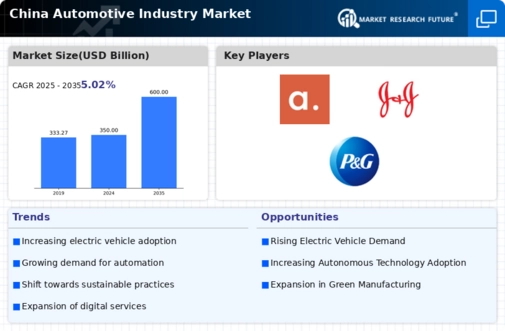China Automotive Industry Size
China Automotive Industry Market Growth Projections and Opportunities
The market factors influencing the automotive industry in China are characterized by a dynamic interplay of economic, regulatory, technological, environmental, and consumer-driven considerations. China has become the world's largest automotive market, and economic factors, including GDP growth, disposable income levels, and urbanization, significantly impact the demand for vehicles. The expanding middle class and increasing urbanization contribute to a growing consumer base with a rising appetite for automobiles. Economic fluctuations, trade policies, and government incentives for the automotive sector play a crucial role in shaping market dynamics.
Regulatory standards and government policies exert a substantial influence on the Chinese automotive industry. The Chinese government has implemented various measures to promote electric vehicles (EVs), reduce emissions, and enhance overall vehicle safety. Regulatory initiatives, such as new energy vehicle (NEV) subsidies, emission standards, and vehicle safety requirements, impact the design, production, and market positioning of automobiles. Compliance with these regulations is critical for automotive manufacturers to maintain a competitive edge and access government incentives.
Technological advancements and innovation are pivotal factors driving the dynamics of the Chinese automotive industry. China is at the forefront of developments in electric and autonomous vehicles, with significant investments in research and development. The push towards electric mobility is influenced by environmental concerns, energy security, and the government's commitment to reducing pollution. Automotive companies that invest in cutting-edge technologies, such as electric drivetrains, connectivity features, and autonomous driving capabilities, are better positioned to meet consumer expectations and regulatory requirements.
Environmental considerations, particularly air quality concerns, have heightened the focus on green and sustainable practices within the Chinese automotive industry. The promotion of electric vehicles, adoption of stricter emission standards, and the implementation of green manufacturing practices are integral to addressing environmental challenges. Manufacturers emphasizing sustainability, energy efficiency, and eco-friendly technologies align with the government's environmental goals and consumer preferences, influencing market positioning and competitiveness.
Consumer preferences and behaviors play a significant role in shaping the Chinese automotive market. The preferences for SUVs, electric vehicles, and advanced connectivity features are notable trends. Chinese consumers increasingly prioritize safety, innovative design, and in-car technologies. As the market becomes more diverse, automotive manufacturers must adapt to changing consumer preferences, offering a range of models and features to cater to different segments of the population.
Market competition and collaboration within the Chinese automotive industry contribute to its dynamic nature. Both domestic and international automakers operate in China, fostering a competitive landscape. Joint ventures, partnerships, and collaborations between Chinese and global automotive companies influence market positioning, technology exchange, and product offerings. Strategic alliances with local partners are crucial for foreign companies seeking to navigate the complexities of the Chinese market.
Infrastructure development and government initiatives for new energy vehicles (NEVs) impact the adoption of electric vehicles in China. The establishment of a robust charging infrastructure is essential for the widespread acceptance of electric vehicles. Government incentives, subsidies, and the promotion of NEVs are driving the market for electric cars. The success of electric vehicles is closely tied to the availability of charging stations and the convenience they offer to consumers.
The global economic landscape, trade relations, and geopolitical factors also contribute to the market dynamics of the Chinese automotive industry. As a major player in the global economy, China's automotive market is influenced by international trade policies, geopolitical tensions, and economic conditions in key markets. Changes in global economic dynamics can impact exports, imports, and collaborations within the automotive sector.
The COVID-19 pandemic has introduced unprecedented challenges and opportunities for the Chinese automotive industry. Disruptions in supply chains, manufacturing operations, and changes in consumer behavior have reshaped the industry landscape. The pandemic has accelerated digital transformation, online sales channels, and contactless services, prompting automakers to adapt their strategies to the evolving market conditions.
The market factors of the Chinese automotive industry are shaped by a combination of economic conditions, regulatory standards, technological advancements, environmental considerations, consumer preferences, market competition, infrastructure development, and global economic dynamics. Automotive companies operating in China must navigate these multifaceted factors to stay competitive, meet regulatory requirements, and address the evolving needs and preferences of Chinese consumers. The strategic alignment with government policies, sustainability goals, and technological trends will continue to influence the success and resilience of the Chinese automotive industry in the rapidly changing automotive landscape.







Leave a Comment